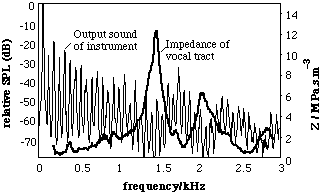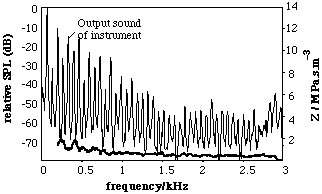Physics of the didgeridoo (didjeridu or
yidaki)
This page is an appendix to a scientific
paper on the vocal tract and the sound of the yidaki (also
known as didjeridu or didgeridoo). It presents sound files,
spectra and impedance measurements from experiments in which
the acoustical impedance spectrum of the player's vocal tract
was measured, during performance, just inside the lips.
For an introduction to
the acoustics of the yidaki, see Acoustics
of the Yidaki/ Dijeridu.
Here we explain the production of strong formants in the
sound of the instrument. This sound file consists of a sample
of the "high tongue" sound, followed by a sample the "low
tongue" sound. This pair of samples is repeated three times.
Spectra of the two sounds are shown below.
 . . . Download sound file in .wav format (700 k)
. . . Download sound file in .wav format (700 k)
| To produce the "high tongue" or high
drone sound, the tongue is held close to the hard palate
to make a narrow constriction. Consequently, the acoustic
impedance has high values at the resonances, as shown
in the figure at left below. The frequencies at which
the impedance is high correspond to resonances that have
pressure antinodes and velocity nodes near the lips. Consequently,
there is very little acoustic flow into the instrument
at these frequencies, and so a minimum in the spectral
envelope (figure at left). Between these minima, the flow
is not impeded so much, and so there are formants, or
peaks in the spectral envelope, at frequencies at which
the impedance is low. |
To produce the "low tongue" sound,
the tongue lies low in the mouth (figure at right). Even
at the resonant frequencies, the acoustic impedance is
lower, because of the larger aperture. Consequently, the
acoustical flow at these frequencies is not inhibited
substantially and there are no strong formants. Note the
absence of the strong formant in both the spectrum and
the sound files. Note that, in the sound files, the pitch
as well as the timbre is changed by the tongue position.
We have reported on this effect in the trombone in another
study.
|
| 
Sound spectrum and vocal tract impedance
for "high tongue" configuration |

Sound spectrum and vocal tract impedance
for "low tongue" configuration |
The curves are typical. In the high tongue configuration (left),
maxima in of the spectrum of the output sound correlated well
with minima in the impedance spectrum (a correlation coefficient
0.98 for 46 measurements on three players).
In the sound file, although the sound is clearly that of
a yidaki with a pitch below that of the normal human voice.
Nevertheless, it sounds a little like someone alternating
between the sound "ee" (the vowel in the English word "heed")
and an indistinct vowel something like "aw" (the vowel in
"hoard" or "hot"). In a previous study, we measured the resonances
of the vocal tracts during speech. Vocal tracts pronouncing
"heed" have a strong resonance at about 1.8 kHz, while tracts
pronouncing "hoard" or "hot" have no resonances between 1
and 2 kHz.
Another important tract configuration is that used for 'circular
breathing', during which the soft palate seals the mouth from
the nasal cavity, allowing the player to inhale from nose
to lungs while expelling air stored in the inflated cheeks
into the instrument. This is studied as part of a much larger
study on the yidaki.
In our paper
on the yidaki, we briefly discuss the importance of the glottis
(the aperture left open between the vocal folds) in the production
of strong resonances in the vocal tract in the kHz region.
When the vocal folds are nearly closed, as they are for speech,
the reflection coefficient for sound waves travelling down
the vocal tract is high for all but very low frequencies.
When the vocal folds are relaxed and open, the reflection
coefficient for frequencies near 1 kHz is much lower: sound
waves in the upper airway are more readily transmitted to
the lower airway and to the highly lossy lungs. Consequently,
the resonances of the vocal tract are weaker.
It is both practically and ethically problematic to measure,
with a nasendoscope, the opening of the glottis of a human
yidaki player during performance. For this and other reasons,
we have made studies using an artificial system for playing
the yidaki, in which the "glottis" opening in the artificial
vocal tract can be accurately controlled. Measurements on
such systems show weaker resonances and weaker formants when
the glottis is open. This is in agreement with simple mathematical
models. Both the artificial playing system and the physical
models are the subjects of extended papers to be presented
elsewhere.
The yidaki project combines several different elements. On the
experimental side, the major advance has been the development
of a system that can measure the acoustical impedance of the
vocal tract during performance on the yidaki. In this situation,
the sound level in the mouth can be 100 dBA, which seriously
complicates the making of mesaurements. Other aspects of the
project involve theoretical modelling of the instrument, the
lips, the vocal tract and the lower airway and their interaction.
Much of this work is applicable to other musical instrument-player
interactions, and indeed to other aspects of acoustics.
Several people have worked or are working on various aspects
of the yidaki project:
Alex
Tarnopolsky [1], Neville
Fletcher [1,2], Benjamin
Lange [1], Lloyd
Hollenberg [3], John
Smith [1] and Joe
Wolfe [1].
[1] The University of
New South Wales, [2] The
Australian National University and [3] The
University of Melbourne.
We gratefully acknowledge the support of the Australian
Research Council. |

